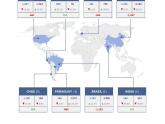Between January and March 2023, Argentine exports totalled US$ 15.9 billion and imports, US$ 17.2 billion. The trade balance recorded a deficit of US$ 1.3 billion.
Highlights:
- In the first three months of 2023, exports amounted to US$ 15.9 billion, the second highest for that period since 2013, only surpassed by those of January-March 2022. They accumulate a year-on-year contraction of 17.9%, which is accounted for by a fall of 15.6% in quantities, while prices decreased 2.8%.
- Exports of all major items decreased, except those of Fuels and energy, which experienced a year-on-year rise of 2.9%, due to the increase in the quantities exported.
- Imports totalled US$ 17.2 billion in the first quarter; they dropped 4.4%, as a result of a 6.5% contraction in quantities that outpaced the 2.3% increase in prices.
- This decrease was explained by lower imported quantities of Fuels and lubricants, Capital goods and Passenger motor vehicles and, to a lesser extent, of Consumer goods and Intermediate goods. Increases in the imported values of Parts and accessories for capital goods stand out, due to greater quantities and price rises.
- A trade deficit of US$ 1.3 billion was registered, resulting from the greater contraction of exports than of imports. In the same period of 2022, a surplus of US$ 1.4 billion had been reached.

- The main increases in exports correspond to motor vehicles for the transport of goods of total weight, with a maximum load, of less than or equal to 5 tonnes (US$ 295 million); natural gas in gaseous state (US$ 123 million) and fuel oil (US$ 97 million). The largest export decreases were seen in wheat (−US$ 1.8 billion), soybean meal and pellets (−US$ 759 million), biodiesel, maize (−US$ 303 million), soybean oil (−US$ 245 million) and crude oil (−US$ 182 million).
- It is worth highlighting the increases in the export prices of three products of the soybean complex: beans, 44.2%, flour, 9.2%, and biodiesel; whereas those of oil decreased (−13.1%). In relation to the quantities exported, decreases were recorded in flours and pellets (−37.4%), oil (−8.2%) and biodiesel; while those of beans increased (192.2%).
- Regarding imports, there stand out the largest purchases of soybeans (US$ 736 million), iron or steel pipes, used in oil and gas pipelines, (US$ 160 million) and electrical energy (US$ 125 million), while purchases of diesel oil (−US$ 341 million), automatic machine units for data handling or processing (−US$ 135 million) and vaccines (−US$ 125 million) decreased.

-The three main trade partners, Brazil, China and the United States, absorbed as a whole 33.0% of the exports and supplied 52.9% of the imports from January-March 2023. In turn, the European Union concentrated 10.4% of shipments and 15.5% of purchases.
- The largest surpluses were in trade with Chile (US$ 956 million), Peru (US$ 759 million), Indonesia (US$ 310 million) and Colombia (US$ 300 million).
- The highest deficits were recorded with China (US$ 1.9 billion), Brazil (US$ 1.2 billion), Paraguay (US$ 806 million), United States (US$ 667 million), Germany (US$ 555 million) and Thailand (US$ 363 million).




